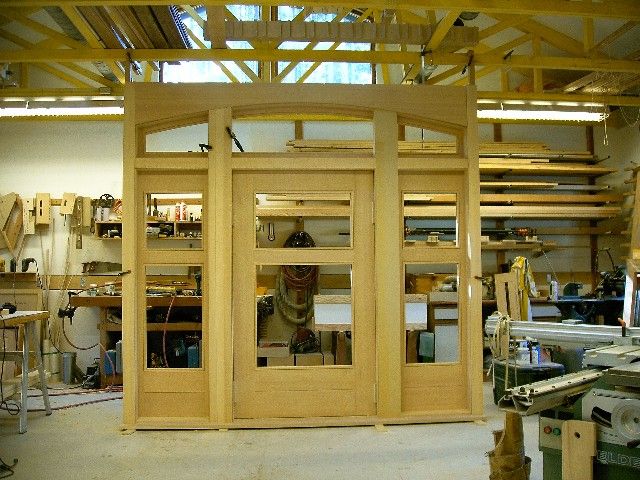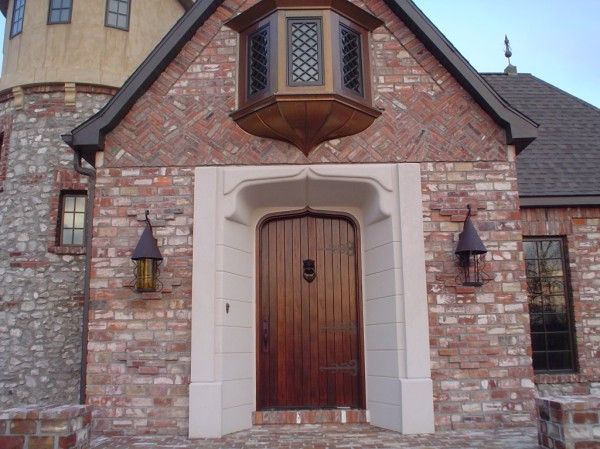Question
How many hinges would you use for a door that is 46" wide by 80" tall, 2 1/4" thick with glass panels (glass units made of 3 pieces of glass - art glass inside sealed unit)?

Forum Responses
(Architectural Woodworking Forum)
From contributor M:
How much does the door weigh? Hinge manufacturers have tables for weight and size of hinges based on door weight and expected usage. That said, I'd probably use 4 - 4.5" ball bearing hinges (high quality, of course) and would space them a little differently than the old standard of 7 down and 11 up. I'd come down around 5 on top hinge and up probably 8 on bottom hinge. I also will make the top hinge mortise a 64th or less deeper than the middle 2, and a 64th shallower for the bottom hinge mortise (or use a thin cardboard shim and keep mortise same as middle 2). Even with high quality hinges with tight tolerances, with all that weight (gravity) pulling on that top hinge, it will sag eventually. It's imperative that the hinge jamb be rock solid tight at exact top and bottom hinge locations - that includes tightening up framing before you set the jamb. No sponginess - if possible add extra blocking, or even 4 X post tight to the back of the king stud, etc. Or if it's real heavy, think about using a bottom pivot box mech system.

But I have to disagree with the practice of opening a box of hinges and throwing away the screws to use some we think are better. If you have the proper hinge for the job and you drill the proper sized pilot holes, then you can rest assured that the hinge will perform as it should for as long as the door is there. These things are tested by real scientists in real lab coats through millions of cycles without failure. I should point out that I'm referring to architectural-grade hinges here.
Residential grade hinges with a 1-1/4" radius corner on a steel/fiberglass door, hung in a fingerjointed pre-prime jamb - that may be different story. The screws that are supplied with these are 3/4" long at best. That's so they can ship the door installed in the jamb and not have the hinge screws poking out.
But 1 1/4 in. screws are not long enough to reach through a 3/4 in. jamb and deep enough into a trimmer to secure the hinge on a 3/0 door, let along a 4/0 door. Especially if the jamb has any shims behind it, which they most always do. I know this from experience. We have hung hundreds of big doors in office buildings, schools, hospitals, and homes. Often hundreds in a single building. And it has always been our responsibility to supply those screws, which are not easy to come by, especially in colors that match the hinges. I can not count the number of times I have used Timely touch-up kits to spray paint the heads of steel screws, first poking the screws through a cardboard box.
Hinge manufacturers and the Door Council of AAAMA also recommend one long screw through each hinge in a wood jamb: “Every entry door with wood framing is supposed to have at least one long screw installed through each hinge that penetrates into the framing stud,” Fortun says (VP of Door Council).
We also supply dummy steel screws for the inevitable in and out that the doors go through, so the brass screws can be saved until they are required.
You would be surprised (or maybe not) how many times both recommendations are completely ignored. We even get calls from concerned job supers as to why we sent all those "extra screws, and what are they for?"
I especially like it when the carpenters pull the hinge pins on mated hinges, ignoring the hinge manufacturer's plain and simple notice about not mixing the hinge leafs, then call back to complain that our hinges are not very good since they don't fit very well.
I don't think a lot of builders know that they're supposed to use a long screw in each hinge. Frankly, I never used one in the two lower hinges, just the top two on 8/0 doors, and often just the top hinge on a 6/8 door, but for really heavy mothers, and wide doors... every screw counts.
If you don't secure the hinge and jamb, even the slightest bow in the jamb will increase the hinge gap just above the top hinge - the gap between the door and the jamb. When that happens, the head gap above the lock stile increases a little bit (sometimes a lot), and the strike gap between the lock stile and the jamb starts to close, especially near the top of the door.
Nails will not by themselves secure a jamb holding a heavy door.
Doors of this size should be hung on bare minimum 5/4 jamb material (not including the stop). I prefer 6/4 - the bigger and heavier the door, the bigger and thicker the jamb should be. In my experience over the last 25 years hanging doors of all kinds, this does make a difference how well the door sits in the frame and swings. Problem is most architects and builders never allow for that (more than "door call out + 2") in the plans and even if they did, the chances the framer would actually catch that wider rough opening "call out" are slim to none.
Gary mentioned in his first post that "it's not the hinge that fails, it's the jamb." I agree in principle, but feel it's really the carpenter who installed the jamb improperly that failed. Craftsmen who care about how it functions and will look 10, 20 or more years from now go the extra mile and take the time to do it right the first time. Hinges do fail over time -anything man made does, and hinges are no exception. I've seen enough metal dust oozing out of hinge knuckles to prove that. Heavy weight architectural grade hinges installed properly on a properly hung jamb will likely outlast the door or even the house, for that matter? Time will tell.